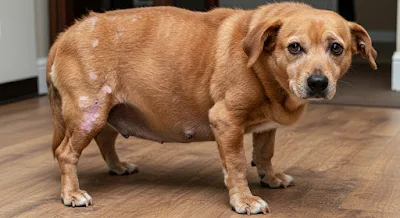🐾 Is Hair Loss and Weight Gain in Dogs Just Part of Aging?
If their facial expression looks sad, hypothyroidism might be the cause!
When a dog appears sad, gains weight, or loses fur, many owners might think it's just part of aging or a habitual change. However, not many are aware that these can be early symptoms of hypothyroidism. Hypothyroidism occurs when there is a lack of thyroid hormone (T4), leading to a slow metabolism and various changes in the dog’s body. If left untreated, it can lead to serious health issues.
🐶 What is Hypothyroidism?
Hypothyroidism is a condition in dogs where a lack of thyroid hormones slows down their metabolism. It most commonly occurs in middle-aged or older dogs, but it can affect dogs of any age. This disease requires long-term management rather than a complete cure. If not properly treated, it can lead to various complications.
Main Symptoms
- Hair Loss: Especially noticeable on the torso or legs.
- Weight Gain: Dogs gain weight even without overeating, and the weight is hard to lose despite efforts.
- Fatigue and Decreased Activity: The dog becomes less active and may appear frequently sad.
- Sensitivity to Cold: The dog becomes more sensitive to cold, and their body tends to feel cold and tense up.
- Skin Problems: The skin may become dry and flaky, showing visible changes.
🐕🦺 Post-Diagnosis Care
Hypothyroidism requires long-term management rather than a cure. In addition to medication, changes in lifestyle are essential. With appropriate care, an owner can help stabilize their dog’s condition.
Levothyroxine Medication
- Administer the prescribed dosage 1-2 times daily as directed by your veterinarian.
- Weight Management: Switch to high-protein, low-fat food and limit treats to control weight.
- Skin Supplements: Use supplements like omega-3, biotin, and EPA/DHA to support skin and coat health.
- Indoor Temperature Control: Ensure a warm indoor space for the dog, especially during winter, as they are sensitive to cold.
- Short Walks: Avoid excessive exercise. Keep walks short to ensure the dog maintains activity without overexertion.
Levothyroxine Dosage
The primary medication for treating hypothyroidism is Levothyroxine. This medication helps supplement thyroid hormones, normalize metabolism, and improve symptoms. It’s important to follow the dosage instructions carefully for effective treatment.
Dosage:
Typically, 0.02mg/kg (0.02mg per kg of body weight) is given 1-2 times per day.
Example: For a 10kg dog, the dosage would be 0.2mg/day (as prescribed, it may be divided into smaller doses).
Start with a lower dosage and adjust gradually based on symptom improvement.
Administration Time:
Levothyroxine should be given on an empty stomach. Ideally, administer it one hour before breakfast at a consistent time each day.
Do not give with meals, as it can affect absorption.
Precautions:
- Spacing: Separate the administration of antacids, iron supplements, and calcium supplements by at least 2-4 hours.
- Side Effects: Overdose may cause symptoms such as increased heart rate, anxiety, or weight loss. If these occur, contact your vet immediately.
Blood Test Monitoring Plan
After starting treatment, regular blood tests are necessary to monitor thyroid hormone levels and ensure the treatment is effective.
Initial Treatment Phase:
- Check T4 levels 4-6 weeks after starting medication.
- The goal is to maintain T4 levels within the upper-middle range of normal.
- Assess symptom improvement and adjust treatment as needed.
Maintenance Phase:
- Once stable, test blood every 6 months.
- For high-risk breeds or senior dogs, test every 3-4 months to monitor changes in hormone levels and adjust medication.
Monitoring Frequency:
Once stable, tests may be conducted every 6-12 months, depending on the dog’s condition. Your vet may adjust the monitoring frequency based on individual needs.
⚠️ Additional Considerations
Diagnosis Complexity:
Hypothyroidism cannot be confirmed with just a blood test. It requires a comprehensive evaluation of free T4, TSH, and thyroid antibodies, along with differentiation from other conditions (e.g., Cushing’s syndrome, kidney disease).
Non-Specific Symptoms:
"Sad-looking face" is subjective, so it’s helpful to record videos and consult with your vet for an objective assessment. Additionally, weight gain may be caused by other conditions like diabetes or heart disease.
Self-Diagnosis Not Possible:
Symptoms alone are not enough for a diagnosis. Professional veterinary tests are necessary.
📌 Additional Tips
- Medication Storage: Keep Levothyroxine in its original packaging, away from light and moisture.
- Food Changes: After 2-3 months of treatment, you may notice hair regrowth and other improvements.
⚠️ If Left Untreated...
If hypothyroidism is left untreated, the dog's condition can worsen over time.
- Cardiovascular stress can lead to heart disease.
- Slower metabolism can result in reduced body function and weakened immunity.
- Skin and coat issues will worsen, greatly affecting the dog’s quality of life.
Therefore, early detection and treatment are crucial. Be sure to consult a veterinarian at the first sign of symptoms, get a proper diagnosis, and begin treatment promptly.
By appropriately managing Levothyroxine administration and conducting regular blood tests, you can help maintain your dog’s health and well-being.







